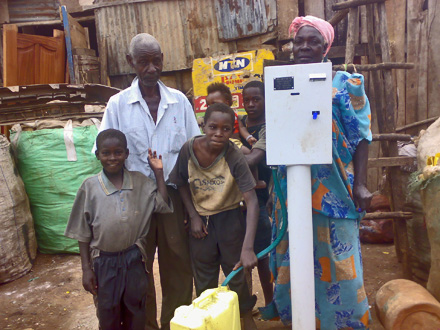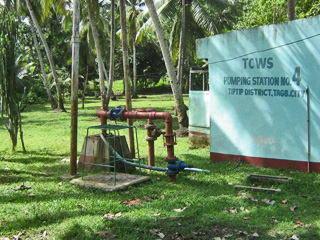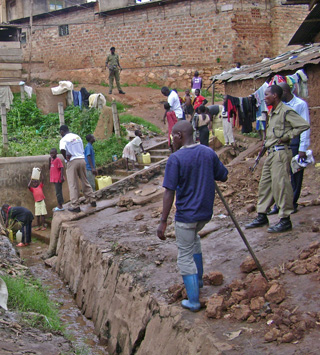Navigation
Report Identifies Barriers, Offers Solutions to Water and Sanitation Service Delivery
Giving poor people a say in the water and sanitation services they receive, and allowing alternative documentation to prove residence are some of the simple solutions that can bring sustainable water and sanitation services to the hundreds of millions currently living without, according to a new report released on August 18, 2009 by the Water and Sanitation Program (WSP).
 |
| Happiness brought about by affordable clean water for urban poor. Photo © National Water and Sewerage Corporation (NWSC) Uganda |
Giving poor people a say in the water and sanitation services they receive, and allowing alternative documentation to prove residence are some of the simple solutions that can bring sustainable water and sanitation services to the hundreds of millions currently living without, according to a new report released on August 18, 2009 by the Water and Sanitation Program (WSP).
According to UNICEF and WHO, 900 million do not drink safe water and 2.5 billion people live without access to improved sanitation, leading to millions of deaths every year, mostly of children under five.
 |
| Pumping Station: A pumping station in one of the Philippine many medium-sized cities. Small water utilities serve a third of all Filipinos who are connected to network systems. Photo WSP |
The report, Guidance Notes on Services for the Urban Poor: A practical guide for improving water and sanitation services, identifies barriers to service delivery for poor people living in urban areas in Africa, East and South Asia, and Latin America and recommends practical solutions to overcome them.
 |
| Typical informal water point in Kisenyi slums, Uganda. Photo © National Water and Sewerage Corporation (NWSC) Uganda |
“Hundreds of millions of people are living in these conditions, but the underlying reasons preventing service delivery can vary depending on whether a person lives in the city or in the countryside,” said WSP Program Manager Jae So. “To identify appropriate solutions, we must identify these contexts, examine the barriers, and formulate logical and practical steps that can be implemented to overcome them.”
Citing an example from the report, Senior Water and Sanitation Specialist Dennis Mwanza said “Project designers and service providers often assume they know what type of services the poor want and are willing to pay for. Their assumptions are not always correct and often result in costly and unsustainable, supply-driven public programs. Giving the poor the opportunity to participate in planning and design can mean the difference between success and failure.”
Among other solutions, the study added that simplified, client-friendly procedures for billing, collection, and connection help the poor to gain and retain access to water and sanitation services.
The report includes a compilation of 19 case studies from 12 countries as well as consultations with urban poor communities to analyze similar barriers and propose solutions.
Case studies from the Guidance Notes demonstrate that the issues involved go well beyond mere investment in infrastructure. The crux of the matter often lies in the establishment of underlying systems of affordable, hygienic, and sustainable service delivery.
For a copy of the full report, or for more on the Water and Sanitation Program, please visit www.wsp.org .
The Water and Sanitation Program (WSP) is a multi-donor partnership created in 1978 and administered by the World Bank to support poor people in obtaining affordable, safe, and sustainable access to water and sanitation services.
WSP provides technical assistance, facilitates knowledge exchange, and promotes evidence-based advancements in sector dialogue. WSP has offices in 25 countries across Africa, East Asia and the Pacific, Latin America and the Caribbean, and South Asia. WSP’s donors include Australia, Austria, Canada, Denmark, Finland, France, the Bill and Melinda Gates Foundation, Ireland, Luxembourg, Netherlands, Norway, Sweden, Switzerland, United Kingdom, United States, and the World Bank. For more information, please visit http://www.wsp.org/.
 |
| “Hundreds of millions of people are living in these conditions, but the underlying reasons preventing service delivery can vary depending on whether a person lives in the city or in the countryside,” said WSP Program Manager Jae So. “To identify appropriate solutions, we must identify these contexts, examine the barriers, and formulate logical and practical steps that can be implemented to overcome them.” Photo WSP |
Safe Water and Sanitation Still Out of Reach for Billions
An opinion piece by Ms. Jae So, the Manager of the Water and Sanitation Program
Although the water and sanitation sector often lives in the shadow of other development topics such as HIV/AIDS, the fact is that more children under five die from illnesses related to poor water and sanitation than from HIV/AIDS, malaria, and tuberculosis combined. Today, there are still 900 million people drinking unsafe water and 2.5 billion people living without improved sanitation, suffering daily the consequences of this shocking situation.
This week in Stockholm at World Water Week, hundreds of water, sanitation and hygiene professionals are placing the spotlight on these issues, hoping to find answers that reduce the millions of annual deaths and instances of illness, and billions of dollars in annual economic losses caused from poor water and sanitation.
One area of intervention is providing water and sanitation services for poor people living in urban areas, who comprise more than 70 percent of the urban population in developing countries. This is a growing concern because of rapid urbanization in many of these countries. In Guidance Notes on Water and Sanitation Services for the Urban Poor, the Water and Sanitation Program (WSP) believes that some of the answers we and our partners derived from case studies of developing countries around the world will contribute to identifying solutions at Stockholm and beyond.
The studies from Bangladesh, Brazil, Honduras, India, Kenya, Pakistan, Peru, the Philippines, Senegal, Tanzania, Uganda and Zambia demonstrate that the issues go well beyond basic investments in infrastructure to underlying systems of affordable, hygienic and sustainable service delivery.
For example, we learned that giving poor people the opportunity to participate in the planning and design phase can be the determining factor in whether a project succeeds in bringing sustainable water access.
We also learned that vested interests among water vendors, landlords, public officials, and utility staff may sometimes prevent better service delivery for poor people, but that confrontations are avoided by giving informal service providers and others new roles or incentives that bring them into the formal system. We have also seen examples of how recognizing, legitimizing and providing finance to small private service providers can promote the expansion of acceptable services to neighborhoods not served by any utility company.
Public awareness campaigns that encourage politicians and others to support water and sanitation access for the poor have also proven successful.
We know that land ownership and tenure issues often create barriers to the provision of services to poor people. One approach that demonstrated success was to allow alternative documentation to prove residence, since many poor people do not have traditional land titles.
World Water Week participants, Government officials, sector practitioners, private sector and aid organizations can seek out and expand on water and sanitation lessons and programs that are proven to work. If we harmonize our efforts through initiatives such as the Global Framework for Action, give Finance Ministries the evidence needed to allocate necessary resources, and foster favorable legal and regulatory frameworks that encourage accountability and incentivize new players, we can bridge the gaps in the road to successful achievement of the Millennium Development Goals on water and sanitation.
The challenge ahead is great, but there are signs of hope. According to UNICEF and the World Health Organization, 1.6 billion people have gained access to improved drinking water and 1.2 billion have gained access to improved sanitation since 1990. Working together we can continue to make progress, through 2015 and beyond, when the lack of these basic services becomes a thing of the past.
The information in this article was provided by WSP.
Search
Latest articles
Agriculture
- World Water Week: Healthy ecosystems essential to human health: from coronavirus to malnutrition Online session Wednesday 24 August 17:00-18:20
- World Water Week: Healthy ecosystems essential to human health: from coronavirus to malnutrition Online session Wednesday 24 August 17:00-18:20
Air Pollution
- "Water and Sanitation-Related Diseases and the Changing Environment: Challenges, Interventions, and Preventive Measures" Volume 2 Is Now Available
- Global Innovation Exchange Co-Created by Horizon International, USAID, Bill and Melinda Gates Foundation and Others
Biodiversity
- It is time for international mobilization against climate change
- World Water Week: Healthy ecosystems essential to human health: from coronavirus to malnutrition Online session Wednesday 24 August 17:00-18:20
Desertification
- World Water Week: Healthy ecosystems essential to human health: from coronavirus to malnutrition Online session Wednesday 24 August 17:00-18:20
- UN Food Systems Summit Receives Over 1,200 Ideas to Help Meet Sustainable Development Goals
Endangered Species
- Mangrove Action Project Collaborates to Restore and Preserve Mangrove Ecosystems
- Coral Research in Palau offers a “Glimmer of Hope”
Energy
- Global Innovation Exchange Co-Created by Horizon International, USAID, Bill and Melinda Gates Foundation and Others
- Wildlife Preservation in Southeast Nova Scotia
Exhibits
- Global Innovation Exchange Co-Created by Horizon International, USAID, Bill and Melinda Gates Foundation and Others
- Coral Reefs
Forests
- NASA Satellites Reveal Major Shifts in Global Freshwater Updated June 2020
- Global Innovation Exchange Co-Created by Horizon International, USAID, Bill and Melinda Gates Foundation and Others
Global Climate Change
- It is time for international mobilization against climate change
- It is time for international mobilization against climate change
Global Health
- World Water Week: Healthy ecosystems essential to human health: from coronavirus to malnutrition Online session Wednesday 24 August 17:00-18:20
- More than 400 schoolgirls, family and teachers rescued from Afghanistan by small coalition
Industry
- "Water and Sanitation-Related Diseases and the Changing Environment: Challenges, Interventions, and Preventive Measures" Volume 2 Is Now Available
- Global Innovation Exchange Co-Created by Horizon International, USAID, Bill and Melinda Gates Foundation and Others
Natural Disaster Relief
- STOP ATTACKS ON HEALTH CARE IN UKRAINE
- Global Innovation Exchange Co-Created by Horizon International, USAID, Bill and Melinda Gates Foundation and Others
News and Special Reports
- World Water Week: Healthy ecosystems essential to human health: from coronavirus to malnutrition Online session Wednesday 24 August 17:00-18:20
- STOP ATTACKS ON HEALTH CARE IN UKRAINE
Oceans, Coral Reefs
- World Water Week: Healthy ecosystems essential to human health: from coronavirus to malnutrition Online session Wednesday 24 August 17:00-18:20
- Mangrove Action Project Collaborates to Restore and Preserve Mangrove Ecosystems
Pollution
- Zakaria Ouedraogo of Burkina Faso Produces Film “Nzoue Fiyen: Water Not Drinkable”
- "Water and Sanitation-Related Diseases and the Changing Environment: Challenges, Interventions, and Preventive Measures" Volume 2 Is Now Available
Population
- "Water and Sanitation-Related Diseases and the Changing Environment: Challenges, Interventions, and Preventive Measures" Volume 2 Is Now Available
- "Water and Sanitation-Related Diseases and the Changing Environment: Challenges, Interventions, and Preventive Measures" Volume 2 Is Now Available
Public Health
- Honouring the visionary behind India’s sanitation revolution
- Honouring the visionary behind India’s sanitation revolution
Rivers
- World Water Week: Healthy ecosystems essential to human health: from coronavirus to malnutrition Online session Wednesday 24 August 17:00-18:20
- Mangrove Action Project Collaborates to Restore and Preserve Mangrove Ecosystems
Sanitation
- Honouring the visionary behind India’s sanitation revolution
- Honouring the visionary behind India’s sanitation revolution
Toxic Chemicals
- "Water and Sanitation-Related Diseases and the Changing Environment: Challenges, Interventions, and Preventive Measures" Volume 2 Is Now Available
- Actions to Prevent Polluted Drinking Water in the United States
Transportation
- "Water and Sanitation-Related Diseases and the Changing Environment: Challenges, Interventions, and Preventive Measures" Volume 2 Is Now Available
- Urbanization Provides Opportunities for Transition to a Green Economy, Says New Report
Waste Management
- Honouring the visionary behind India’s sanitation revolution
- Honouring the visionary behind India’s sanitation revolution
Water
- Honouring the visionary behind India’s sanitation revolution
- Honouring the visionary behind India’s sanitation revolution
Water and Sanitation
- Honouring the visionary behind India’s sanitation revolution
- Honouring the visionary behind India’s sanitation revolution

